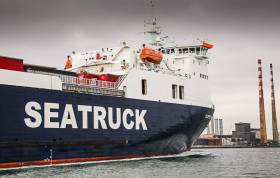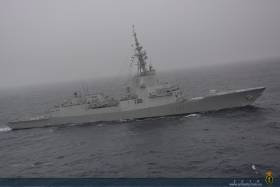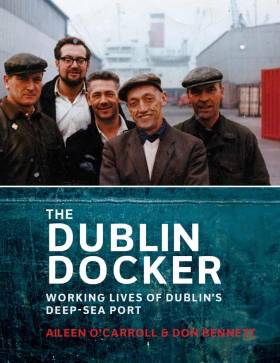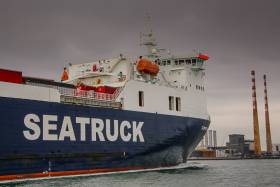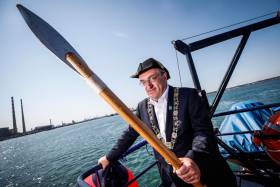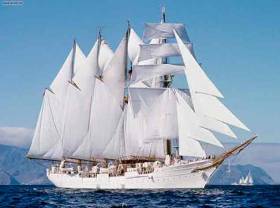Displaying items by tag: Dublin Port
Heads Up On Eden Quay: Historic Crest of the 'City of Dublin Steam Packet Company'
#CityOfDublin - It would be hard not to have noticed in particular as a Dublin bus commuter using services at Eden Quay the historic crest of the former City of Dublin Steam Packet Company, writes Jehan Ashmore.
The ornate masonry of the crest depicts the City of Dublin S.P.Co that was established in 1823 and later incorporated from 1833. The crest is to be found on the facade of 13-15 Eden House, on the first floor of the steam packet's former head office. Notably, such a crest is a very rare example in Dublin city and which has such historic shipping connections dating almost 200 years ago.
Facing almost opposite of Eden House are further bus stops located on the quay from where past Dubliner's could conveniently board City of Dublin 'steamers' to the rest of the UK. Noting that Ireland then remained as part of the Union.
The crest is of historical importance given the rarity of such architectural decorative features relating to our shipping heritage. Such an example should be recognised more so in the public domain as part of our national maritime past.
Eden House is on the corner with Marlborough Street where the Abbey Theatre's front entrance is located. To mark the significance of the 1916 Easter Rising centenary last year, images of leading historical figures were placed on the ground floor windows of Eden House. Currently they are adorned with those concerning productions held at the cultural institution also known as the National Theatre of Ireland.
As for the crest itself, the earliest date depicted is 1823 and this refers to when the Irish owned passenger services began when Charles Wye Williams inaugurated the Dublin-Liverpool service. In the following year this route was served by steamships City of Dublin and City of Liverpool.
Afloat will have a follow up on the crest and a more in depth background about the history of the City of Dublin Steam Packet. Also examined will be the relationship with other Irish Sea operators, among them B&I Line that has links to present day ferry operators connecting Dubin with Liverpool and Holyhead.
As developments continue in an increasingly changing city notably downriver in the 'Docklands', it is in this predominantly financial quarter where only a handful of further historical shipping related 'listed' buildings remain standing. These examples along the inner quays recalls an era from Dublin's older port.
The last regular trading ships from this part of the port were Guinness tankers that ceased operations in 1993. Originally the stout company loaded ships on the north side along Customs House Quay which was connected by barges upriver from St. James Gate brewery until this river trade ended in 1961. This led to road tankers taking over to supply the final pair of ships, The Lady Patricia and Miranda Guinness that transferred southside to Sir John Rogersons Quay.
As for Eden Quay's more central city location is located between O'Connell Street Bridge, the capital's main thoroughfare and the Butt Bridge completed in 1932. A previous bridge of the same name had been built at the same location albeit it was a 'swing' bridge that permitted navigation to shipping in the days of sail and steam.
It is along this stretch of the inner city Liffey quays is where commercial traffic exists in the present day albeit confined to the river. This been in the form of a single operator that been Dublin Discovered boat tours. Their excursion craft, Spirit of Docklands (see photo-story) embarks tourists from a berth pontoon at Batchelors Walk. From there the low-air draft craft regularly plies upriver to the Ha'Penny Bridge and as far as the Tom Clarke toll-lift bridge downriver where the modern port begins.
Dublin Port Trade Volumes up 4.2% in First Nine Months of 2017
Dublin Port Company has published its latest trade figures showing growth of 4.2% to the end of Q3 2017. Overall, volumes in Dublin Port have grown by 30.1% in just five years.
A continuation in the current pace of growth would mean a third successive record year for Dublin Port.
Summary of YTD September 2017 Trade Statistics
|
Gross tonnes |
Q3 2017 |
Q3 2016 |
% change |
|
Imports |
16.0m |
15.4m |
3.5% |
|
Exports |
11.2m |
10.6m |
5.2% |
|
Total Throughput |
27.1m |
26.0m |
4.2% |
|
Ro-Ro units |
736,462 |
699,361 |
5.3% |
|
Lo-Lo TEU |
515,718 |
495,511 |
4.1% |
|
Ferry passengers |
1,496,025 |
1,460,585 |
2.4% |
|
Tourist vehicles |
411,921 |
400,949 |
2.7% |
|
Cruise ships |
127 |
103 |
23.3% |
|
Trade vehicles |
73,252 |
77,494 |
-5.5% |
Total throughput (imports and exports) for the nine months to the end of September was 27.1 million gross tonnes, with 5,932 ship arrivals during the period.
Consecutive Growth over the past five years
This is the fifth year in a row for Dublin Port to see substantial growth in the first nine months.
|
Trade Period |
% growth |
|
Q3 2013 |
3.1% |
|
Q3 2014 |
7.2% |
|
Q3 2015 |
5.8% |
|
Q3 2016 |
6.8% |
|
Q3 2017 |
4.2% |
New Ro-Ro Service
Growth was particularly strong in Ro-Ro freight with 736,462 units in the first nine months, an increase of 5.3% on the previous year. Within this total, Ro-Ro services between Ireland and Britain grew strongly at 6.2%. Elsewhere, Lo-Lo containers grew by 4.1% to 515,718 TEU.
As Afloat.ie previously reported, In a new development, Dublin Port Company has confirmed that it will welcome the maiden call of CLdN’s mv Celine at the end of October. Her arrival will provide additional capacity and flexibility for customers trading with markets in Continental Europe, particularly post BREXIT.
Celine will operate between Dublin Port and the ports of Zeebrugge and Rotterdam. With a capacity of 8,000 lane-metres, Celine can carry over 600 freight units and is approaching twice the size of the largest ferry currently operating from Dublin Port.
The volume of new imported trade vehicles through Dublin Port declined by -5.5% during the period, reflecting the large increase in recent times of second-hand vehicle imports from the UK.
Ferry & Cruise Tourism Growth
Tourism volumes on ferries grew strongly in the first nine months, with passenger numbers ahead by 2.4% to 1.5 million. Cruise tourism is also growing in Dublin with 127 cruise ships calling in the first nine months of what is already a record year for Dublin Port.
Eamonn O’Reilly, Chief Executive, Dublin Port Company, said: “Dublin Port’s volumes continue to grow strongly. It is clear that the trend of year on year increases that we saw in the decades before the crash of 2008 has returned. We have now seen five years of consistent growth and each of the last three years has been a record year.
“Notwithstanding the uncertainty generated by BREXIT, Dublin Port has seen Ro-Ro freight volumes on routes to Britain grow by 6.2% over the first three quarters of 2017 with ferry passenger numbers growing by 2.4%.
“We are increasing the capacity of the port on the basis that growth will continue for many years to come. Work is continuing on our first major Masterplan project, the Alexandra Basin Redevelopment (ABR) Project.
“We are seeing increasing demand for direct freight services to Continental Europe. The introduction by CLdN of the 8,000 lane metre Celine will greatly increase the capacity on direct services to Continental Europe. BREXIT is creating a lot of uncertainty and the introduction of the new ship shows the shipping sector beginning to provide additional capacity to create more options for importers and exporters. We expect to see more new services to Continental Europe during 2018.
“Before year end, we will commence construction of a bridge over the Covanta and ESB cooling water outfall on the Poolbeg Peninsula now that the construction of the waste to energy plant is complete. This bridge will bring unused port lands on the Poolbeg Peninsula into use and allow us to increase the capacity of our berths on South Bank Quay. This is the first step towards the ultimate development of all Dublin Port lands on the Poolbeg Peninsula under our Masterplan 2012-2040.
“We welcome the recognition in the recently approved Planning Scheme for the Poolbeg West SDZ that port lands are for port uses. This follows on from the recognition in the draft National Planning Framework of the importance for the country of the continued addition of port capacity in Dublin.”
New Book on Dublin Bay's Nature & History
Dublin City is extremely vulnerable to coastal flooding which could cost at least €340 million in insurance claims alone, according to a new book, Dublin Bay – Nature and History (The Collins Press, price €24.99). Richard Nairn, one of three authors of the book, said, ‘Rising sea levels, increasingly severe storms and poor flood defences will combine to cause frequent flooding of property in the coastal areas of Sandymount and Clontarf.’ He added that there needs to be a high level of cooperation between all state and local authorities to ensure that the capital city is protected from the worst effects of climate change.
Eamonn O’Reilly, Chief Executive of Dublin Port Company, said, ‘The challenge to simultaneously manage, develop and conserve Dublin Bay is formidable and requires an appreciation of both the bay’s natural environment and its built environment.’
Weaving the kindred strands of history and nature, the authors tell the fascinating story of the bay. The development of the port city has been mirrored by major changes in the coastal environment. Geographer and planner Rob Goodbody, said, ‘The human and natural components of the bay have learned to coexist and, in some cases, even to depend on each other. We wanted to show people things like how the creation of Dublin Port caused the formation of Bull Island, or how the cockles and mussels immortalised in “Molly Malone” caused typhoid fever throughout the city.’ Co-author David Jeffrey, added, ‘The bay has stretched its arms widely to embrace countless generations of Dubliners: it is a life support system, an economic asset and an invaluable recreational resource.’ This new look at a familiar seascape authoritatively explains its importance to the past, present and future of our city and country.
Richard Nairn is a writer and ecologist from Dublin. He studied Natural Sciences at Trinity College Dublin and was the first Director of BirdWatch Ireland. He provides ecological advice to local authorities, and supported the UNESCO Biosphere designation of Dublin Bay. An active sailor, he has also walked all the shores of the bay.
David Jeffrey, Emeritus Professor of Biology at Trinity College Dublin, lives in Howth. He was a key researcher on the Dublin Bay Water Quality Management Plan and is a tireless advocate for science-based nature conservation.
Rob Goodbody from Dublin is a geographer and planner. He has written several local histories and regularly leads historic walking tours in Dublin.
Did you know that the River Liffey was much wider and shallower in earlier millennia, before it was confined between the quay walls. At low tide, the mud would have been too soft to support a person’s weight and the only crossing was a wide shallow section of the river, with wicker mats staked to the riverbed, which came to be known by the Irish name of Átha Cliath, or ‘ford of the hurdles’. The name Dubhlinn means ‘black pool’, referring to deeper water where the River Poddle enters the Liffey estuary. Thus, the names of the city itself related to the bay.
Dublin Port, which occupies the mouth of the Liffey, is the gateway for three quarters of the trade entering and leaving Ireland. Six ferry companies operate up to seventeen sailings a day to the UK and over a hundred cruise ships visit each year.
Dublin Bay had the first designated bird sanctuary in Ireland and it now has more designations than any other place in the country. The latest of these is its recognition by UNESCO as a biosphere.
The initiative of Dublin City Council in 2015 to extend the UNESCO designation of Biosphere to the entire area of Dublin Bay and its hinterland was innovative, forward-thinking and a model for good international practice in coastal zone management. The Biosphere is managed through a partnership between three coastal local authorities, Dublin Port Company, Fáilte Ireland and the National Parks and Wildlife Service. This promising start should be the first building block in a development that could cast Ireland as a world leader. In ecological terms, the biosphere is the global ecological system integrating all living beings and their relationships, including their interaction with the physical environment.
Launched in 1971, the Man and the Biosphere Programme (MAB) is an Intergovernmental Scientific Programme that aims to establish a scientific basis for the improvement of relationships between people and their environments. Still in place over four decades later, MAB combines the natural and social sciences, economics and education to improve human livelihoods and the equitable sharing of benefits, and to safeguard natural and managed ecosystems, thus promoting innovative approaches to economic development that are socially and culturally appropriate, and environmentally sustainable.
Price €24.99 / £21.99 • Hardback • 312 pages and available to buy online from Afloat's Marketplace here
- The book will be Launched on Thursday, 2 November in Dublin Port Company. The guest speaker will be Senator David Norris. More launch details here.
Spanish Navy Frigate Among NATO Flotilla to Visit Dublin Following Major Exercise off Scotland
#SpainScotland - French Navy ships are currently visiting Dublin Port with more to come among them the Spanish that also participated in Joint Warrior 172, Europe's largest military exercise for some time that had taken place off Scotland, writes Jehan Ashmore.
The UK led multi-national exercise involving some 30 warships from NATO, numerous aircraft, marines and troops had been testing anti-terrorism tactics, piracy, humanitarian missions and other duties. Asides the French and Spanish the multinational flotilla included the Royal Canadian Navy. All these navies are scheduled each to send a frigate to Dublin before next mid-week.
The French will again be represented by FGS Provence, the fourth caller since yesterday. The other frigates are the Canadian Navy's HMCS Montréal and from Spain Álvaro de Bazán. The country on 1st October drew worldwide attention given the independence referendum held in Catalonia. This was in marked contrast as only yesterday, 12th October was the National Day of Spain.
The “Álvaro de Bazán” class frigate belongs to the 31st Escort Squadron based in Ferrol, Corunna in north-west Spain. The frigate was launched locally in Ferrol on October 27th 2000 at the NAVANTIA Shipyards. The frigates motto and coat of arms is “Rey Servido y Patria Honrada” which translates to Served king and Honoured Homeland.
Another referendum but this time on Scottish independence took place in 2014. It was somewhat ironic that the 147m Spanish frigate had called to Glasgow only last week.
The leadship of the Álvaro de Bazán frigate class is of a modern design that according to the Spanish Navy has a remarkable military capability. The frigate is equipped with an AEGIS Combat System that makes the class a most valuable asset at the service of the Nation’s foreign policy, not only in conventional operations, but also in peace-keeping and humanitarian aid missions, enforcement of UN resolutions, etc.
This year, Joint Warrior 172 overlapped with Formidable Shield 17 - a U.S. led joint NATO live fire Integrated Air Missile Defence (IAMD) exercise. Both exercises had provided a complex environment in which allied units trained together in tactics and skills for use in a combined joint task force.
In addition our very own L.E. James Joyce, the second of three OPV90 /Playwright sisters completed, will dock in Dublin on Monday before this contingent of the NATO flotilla arrive. Firstly on Tuesday, HMCS Montréal is scheduled while on Wednesday it will be the turn of both FGS Provence and Álvaro de Bazán.
In the reporting of visiting naval vessels, the schedules can be fluid, so much so that due to operational reasons such ship visits can be swapped around, delayed or even be cancelled.
Dublin Port Ushers in New Era at Port Centre Opening
Guests of Honour Ardmhéara Bhaile Átha Cliath and Honorary Admiral of Dublin Port, Mícheál Mac Donncha and An Taoiseach Mr. Leo Varadkar TD were in attendance at the official opening of Dublin Port Centre. The project which began last November marks the largest physical intervention by Dublin Port to reintegrate the Port with the City, as committed to in the company’s Masterplan. The project has softened the Port’s boundaries to the City and provides public realm at Port Centre for the first time in 35 years.
MC’d by well-known broadcaster Eileen Dunne the 500-strong crowd, which was made up of members from the communities surrounding the Port, was serenaded by acts including Damien Dempsey, John Sheahan of the Dubliners, The Blades, Lisa O’ Neill, Colm Mac Con Iomaire of The Frames and Catherine Fitzgerald, many of whom were featured in Dublin Port’s 2016 album “Starboard Home”.
Speaking at the official opening ceremony the Ardmhéara, Mícheál Mac Donncha said: “It is a great honour to officially open Dublin Port Centre. The Port is such a huge part of Dublin City’s life and I believe with this project finally completed that connection is set to become stronger and stronger.”
Commenting at the event, Eamonn O’Reilly, Chief Executive, Dublin Port Company said: “Dublin Port is delighted to begin this new chapter of Port City integration. In recent years the connection has waned somewhat but this a new era for the Port. Rebuilding the connection between the Port and the City, which was so strong a century ago, is something which will be at the core of everything we do going forward.”
Speaking at the event, An Taoiseach Mr. Leo Varadkar TD said: “While Dublin Port’s key focus is on its infrastructural development and the import and export needs of the Irish economy, it also has a strong commitment to rebuilding the linkages between the port and the city. This new project will enhance Port-city integration to the benefit of city dwellers and visitors.
“Dublin Port is at the heart of what is emerging as one of the most exciting neighbourhoods in the city, and the opening of this port centre will add to the buzz and energy of this area, as well as providing locals with a host of new amenities to enjoy.”
Port Centre has been a hive of activity in recent months as the development of public space progressed. Projects included the removal of a section of the existing old boundary wall to create new pedestrian entry points at Alexandra Road and East Wall Road. Earlier this month the Port unveiled Crane 292 a newly restored crane from the 1960s which now stands proudly towering over Port Centre.
Visitors can now enjoy a landscaped “maritime” garden with seats for reflection and relaxation. NCAD graduate and up and coming Irish artist Eimear Murphy’s new sculpture ‘The Drop’ features in the garden. The sculpture is made from solid concrete and plays with notions of fluidity in its design. The commissioning of this piece highlights the Port’s long-term commitment to supporting the arts.
Dublin Port Company is now focused on plans for a new internal road network, cycle lanes and pathways. Approved by Dublin City Council and scheduled for development, the three-kilometre route will give pedestrians and cyclists access to the Port estate for recreational use for the first time. It includes a perimeter route with vantage points overlooking the Tolka Estuary.
Dublin Port Company today hosts the launch of The Dublin Docker, Working Lives of Dublin’s Deep - Sea Port, an illustrated book which recalls the era when thousands of men unloaded and loaded the ships by hand on Dublin Docks. The authors of the book Aileen O’ Carroll and the late Don Bennett excavated the archive of the Dublin Dockworkers Preservation Society to discover a wealth of photographs, spanning the mid-nineteenth century to the 1970s.
The Dublin Docker manages to capture the dockers’ arduous labour and the energy of Dublin Port. These evocative images bring the social history to life, complementing the voices revealed in interviews with the dockers themselves.
Dock work was physically hard and dangerous; coal was unloaded with a “Number 7” shovel which could lift up to 26kg of coal. Grain was shovelled into sacks, the dockers avoiding the fat rats which feasted in to the hulls. Timber beams and bags of cement were carried off on shoulders. Metal ore would make tongues go green.
Although the work was tough the humour which abounded among the dockworkers is evident through the colourful nicknames the men bestowed on one another; RubberLegs Gaffney, StakeLoaf Cummins and Professor Flood. The dangerous work lent itself to strong comradeship amongst dockworkers with the days broken up by song competitions and slagging matches.
For some dock work was the only option in lean times, with students and builders making their way down the docks in the summer months. In the 1960s it is recorded that 2,000 men were employed directly on Dublin docks.
The Dublin Docker is a history of the dockers and their deep-woven connection to the city. How they negotiated working hours and pay, the changes that came with epochal events – the Dublin Lockout, the First World War, the Easter Rising and War of Independence – and the innumerable myths and ‘dark stories’ that shrouded their image.
Commenting on the book Eamonn O ‘Reilly, Chief Executive, Dublin Port Company, said: “The Port has such a rich and vibrant history, we are thrilled to be able to support The Dublin Docker, which gives a voice to those men that were the lifeblood of the Port for so long. With the appointment of a Heritage Officer we can now bring more stories like this to life and honour the work of those that lay the foundation of what the Port is now and is set to become.”
Speaking at the launch, the co-author Aileen O’Carroll said: “As a Port city, Dublin owes much to the labourers who strove against the heavy-duty tide of imports and exports; a league of thousands who were hired on a day-to-day basis for generations, defining the bustle of Dublin city centre. The Dublin Docker is an illustrated history that determines the dockers’ and stevedores’ importance as an industrial subculture within the Dublin that they navigated.”
Dublin Port Unveil Four Tonne Stainless Steel Ball
Dublin Port Company is a step closer to opening up its surrounds to the public following the installation of a four tonne Stainless Steel Ball.
Casting Port Centre in a new light, the Ball is inspired by the Time Ball which originally stood on Westmoreland Street. Each day the Time Ball dropped on the top of the Ballast Office at O’Connell Bridge to signal Greenwich Mean Time to ships in port.
From the podium, visitors will also be able to observe the Port’s operations from a safe distance, as intended by the original architects. The installation was conceived by Darmody Architecture as part of Dublin Port Company's plan to open up Port Centre and create new public realm. It will go on public display when the project is completed in the autumn.
Enabling works to prepare the site at Port Centre are ongoing and involve removing a section of the existing old boundary wall to create new pedestrian entry points at Alexandra Road and East Wall Road, identifiable by tall russet coloured structures made from Cor-ten steel, the same material that is used in shipping containers.
Moving south of Port Centre, visitors will discover a landscaped maritime garden with distributed seating, accessible from a new footbridge will connect relocated car park facilities. NCAD graduate and upcoming Irish artist Eimear Murphy’s new sculpture ‘The Drop’ will feature in the garden.
The scheme also fully integrates with Dublin Port’s future plans for a new internal road network, cycle and pathways. Approved by Dublin City Council and scheduled for development, the 3 kilometre route will give pedestrians and cyclists access to the port estate for recreational use for the first time, and includes a perimeter route with vantage points overlooking the Tolka Estuary.
The project which was announced last November will soften the Port’s boundaries into the City and provide public realm at Port Centre for the first time in 35 years.
This is the largest physical intervention by Dublin Port to reintegrate the Port with the City, as committed to in the company’s Masterplan. Works are being carried out by Wills Bros Civil Engineering.
Dublin Port Company has published its latest trade figures showing half-year growth of 2.9%, putting Dublin Port on track for a third successive record year. As Afloat.ie reported yesterday, overall volumes in Dublin Port have grown by 28.8% in just five years.
Growth was driven by exports which were up by 4.4% with imports ahead by 1.9%. The first half included the busiest ever month in the history of Dublin Port with 3.2 million gross tonnes of goods passing through the Port in May.
Given sustained, high levels of growth, Dublin Port Company has commenced work on its second major Masterplan Project, the MP2 Project, to provide additional capacity for future growth. The MP2 Project will create a single unified terminal for three of Dublin Port’s five ferry operators (Irish Ferries, P&O and Stena Line). In doing this, the project will greatly increase the utilisation of Port lands and improve essential facilities for a variety of State functions including immigration, customs, security and other border inspection controls.
Summary of YTD June 2017 Trade Statistics
|
Gross tonnes |
H1 2017 |
H1 2016 |
% change |
|
Imports |
10.5m |
10.3m |
1.9% |
|
Exports |
7.4m |
7.1m |
4.4% |
|
Total Throughput |
17.9m |
17.4m |
2.9% |
|
Ro-Ro units |
485,463 |
460,587 |
5.4% |
|
Lo-Lo TEU |
335,131 |
330,514 |
1.4% |
|
Ferry passengers |
775,867 |
751,086 |
3.3% |
|
Tourist vehicles |
217,249 |
207,921 |
4.5% |
|
Cruise ships |
50 |
42 |
19.0% |
|
Trade vehicles |
56,090 |
61,439 |
-8.7% |
Total throughput (imports and exports) for the six months to the end of June was
17.9 million gross tonnes, with 3,860 ship arrivals during the period.
This is the fifth year in a row for Dublin Port to see substantial growth in the first six months.
|
H1 2013 |
2.0% |
|
H1 2014 |
8.2% |
|
H1 2015 |
5.0% |
|
H1 2016 |
8.0% |
|
H1 2017 |
2.9% |
Growth was particularly strong in Ro-Ro freight with 485,463 units in the first six months, an increase of 5.4% on the previous year. Within this total, Ro-Ro services between Ireland and Britain grew strongly at 6.3%. Elsewhere, Lo-Lo containers grew by 1.4% to 335,131 TEU.
Tourism volumes on ferries grew strongly with passenger numbers ahead by 3.3% to 776,000 in the first six months. Cruise tourism is also growing in Dublin with 50 cruise ships calling in the first six months of what will be a record year for Dublin Port.
The volume of new imported trade vehicles through Dublin Port declined by -8.7% reflecting the large increase in recent times of second hand vehicle imports from the UK.
Eamonn O’Reilly, Chief Executive, Dublin Port Company, said:
“The phenomenal growth we have seen in recent years is continuing, with 2017 set to be the third successive record year for Dublin Port. The 2.9% increase in trade in the first half of 2017 brings our growth in just five years to 29%. At this rate, Dublin Port’s volumes would double in just 14 years.
“Work is well underway on Masterplan projects to provide capacity for future growth. These include the Alexandra Basin Redevelopment (ABR) Project and the development of Dublin Inland Port on a 44-hectare site situated 14 km from the Port.
“We are also starting preliminary work on Dublin Port’s second major Masterplan project, the MP2 Project, with a target of applying for planning permission in late 2018. Planning permission and other consents will take about two years, allowing construction to commence as we approach the end of works under the ABR Project. The MP2 Project will provide much needed additional capacity for Ro-Ro freight and container traffic to the UK and, increasingly, to Continental Europe.
“The major development projects in Dublin Port are being guided by Dublin Port’s Masterplan which we are currently reviewing. At this stage, the review is pointing towards a third and final major Masterplan Project (following on from the ABR Project and the MP2 Project) on the Poolbeg Peninsula. This will bring Dublin Port towards its ultimate capacity and able to accommodate projected future growth all the way to 2040.”
The new Lord Mayor of Dublin, Mícheál Mac Donncha, today took to the waters of Dublin Bay to take part in the annual “Casting of the Spear” ceremony. The “Casting of the Spear” is a tradition dating back 529 years and the first official duty for Lord Mayor Micheál Mac Donncha as Honorary Admiral of Dublin Port at his investiture from Dublin Port Chairperson Lucy McCaffrey. The title of Honorary Admiral of Dublin Port has been bestowed on the Lord Mayor of Dublin for over 20 years.
Historical records show that the maritime tradition of the Casting the Spear dates back to 1488 when Thomas Mayler, who was then Lord Mayor of Dublin, rode out on horseback and cast a spear as far as he could into the sea. This was to mark the city’s boundaries eastwards. Centuries later, the re-enactment ceremony reminds us of Dublin’s role as a port city in medieval times and highlights Dublin Port’s remarkable history since its establishment as a trading post some 1,200 years ago.
Newly invested Honorary Admiral of Dublin Port Mícheál Mac Donncha said;
“It is an honour to perform the ‘Casting of the Spear’ ceremony which has become a highlight in the calendar for the Lord Mayor of Dublin. I look forward to an exciting year ahead as Honorary Admiral of Dublin Port and working with the Port and its communities to create new traditions and memories. It is important that we keep alive the customs and traditions that define us as a port city.”
There to witness the Casting of the Spear ceremony were members of the local port community enjoying the launch of the 30th annual South Docks Festival. The South Docks Festival is run by the St. Andrew’s Resource Centre of Pearse Street in collaboration with a number of local clubs and groups, including Pearse Area Recreational Centre. It is a celebration of community and heritage, taking pride in the identity inherent in the South Dublin Docklands area. The festival takes place from Monday, 17th July – Friday, 21st July with activities, fun and games for all.
Dublin Port Chairperson Lucy McCaffrey commented at the ceremony;
“I would like thank Lord Mayor Mac Donncha for his participation in the Casting of the Spear, a ceremony that celebrates our heritage as a port city. Looking back to the origins of the ceremony, now more than half a century ago, it is extraordinary to think that our city’s boundaries were established as a port city by Thomas Mayler’s spear in the waters of medieval Dublin. Today’s re-enactment celebrates that tradition and is symbolic of Dublin Port’s continued commitment to preserving, for the city and its people, an understanding of the history that binds the port and the city.”
“It is great to celebrate the 30th South Docks Festival, which brings together the communities of our docks and our nearest neighbours. I would like to congratulate the organisers of the festival on a tremendous programme of events and to encourage everyone to come along and enjoy the festivities.”
The Spanish Embassy in Dublin and Dublin Port Company have announced that one of the world’s oldest and largest tall ships, the “Juan Sebastián de Elcano” will make a five-day visit to Dublin Port, arriving on Saturday, 10th June and departing on Thursday, 15th June. The 370-foot long, four-masted schooner is the world’s third largest tall ship and one of the oldest tall ships still sailing.
The majestic steel-hulled schooner led by Captain Victoriano Gilabert will arrive in Dublin Port at 9am on Saturday carrying 245 crew on board. The ship is used as a training vessel for the Royal Spanish Navy, preparing its Officers for long periods at sea. King Felipe VI is among the Officers who have been trained on board the ship, which is named after Spanish explorer Juan Sebastián de Elcano, captain of Ferdinand Magellan's last exploratory fleet, and the first man to circumnavigate the globe.
While in Dublin, the crew will participate in a range of engagements to promote Spanish-Irish cultural exchange, including an open day for the public.
The ship will initially berth at Ocean Pier (no public access) in Dublin Port, before moving to Berth 18 beside the Tom Clarke Bridge, where she will be open to the public to visit free of charge on Wednesday, 14th June. Visitors are welcome to come and see first-hand the craftsmanship and young crew at work on board this stunning vessel.
Public Opening
Date: Wednesday, 14th June
Time: 10.00 to 13.00 and 15.30 to 19.00
Location: Berth 18 (beside Tom Clarke Bridge)
The ship, now on its 89th training voyage, departed from Cádiz (Spain) on March 12th and sailed to Santo Domingo (Dominican Republic) and New York. The ship then set sail across the Atlantic back to Spain and from the Port of Marín is now en route to Dublin Port. Built in Cádiz (Spain) and launched in 1927, the “Elcano” has visited over 197 ports in more than 70 countries, and of its 89 cruises to date, 10 have been round-the-world trips. Since its first voyage she has clocked up more than 1.8 million nautical miles.
The last time the “Elcano” visited Dublin Port was in June 2014. Her next ports of call include Den Helder (The Netherlands) and Antwerp (Belgium) before returning to Spain.
Eamonn O’Reilly, Chief Executive of Dublin Port Company, said: “Dublin Port Company welcomes the return of the Juan Sebastián de Elcano and her crew to Dublin Port. Dublin Port has a longstanding tradition of hosting visiting navy and sharing in the history and culture of other seafaring nations. The Elcano is one of the finest tall ships in the world, and her arrival is sure to capture the interest and imagination of people here, providing a unique opportunity to learn more about Spain’s naval heritage.”
His Excellency, José María Rodríguez Coso, Ambassador of Spain to Ireland, said: “The arrival to Dublin of the Elcano is an event of major importance and significance. The ship is a floating embassy, and the fact that Dublin has been chosen as a port of call symbolises the strength of the bilateral relations between Ireland and Spain.”


























